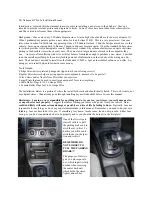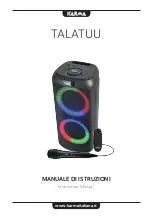
Thermal Overload/Ventilation:
The VA300 is equipped with thermal sensing switches on
the heat-sinks of the output transistors. The thermal switches
a r e s e t t o s h u t o f f A C p o w e r t o t h e a m p l i f i e r w h e n a
temperature of 90°C (194°F) is attained on the heat-sinks; the
switches will automatically recycle and return AC power when
the heat-sink temperature reduces to 73°C (164°F). A thermal
overload light (9), located on the front panel of the VA300,
will indicate if thermal cycling has occurred. Thermal cycling
may occur if air is not allowed to circulate through the grilles
of the amplifier, if there is a prolonged short-circuit on the
speaker output, or if the ambient temperature exceeds 43°C
(110°F) while the console is operating at or near full power.
Thermal cycling may also occur if the speaker load impedance
is less than 5.3 ohms. See page 6,
Output Connections,
for
instructions on speaker connections.
Anti-Feedback Switches:
Acoustic feedback (a howl or squeal in the speakers) may
occur, depending on room acoustics and the physical place-
ment of microphones in relation to the speakers, when volume
is increased or when Bass or Treble controls are boosted. To
m i n i m i z e f e e d b a c k , f o u r A n t i - F e e d b a c k s w i t c h e s ( 1 ) a r e
incorporated in the VA300-C Console. These switches operate
four “notch filters” which modify the frequency response of
the unit. Each switch controls part of the audio spectrum. The
top switch (A-yellow colored) filters the highest feedback
p i t c h ( s q u e a l ) , w h i l e t h e b o t t o m s w i t c h ( D - d e e p o r a n g e
colored) filters the lowest feedback pitch (howl). The middle
switches (B and C) filter the middle feedback pitches. The
action of each filter, with the exception of the (D) filter, has
very little effect on the tonal quality of the voice. When using
the (D) filter, a decrease in bass tones may be noticed. To
compensate for this, simply increase all the Individual Channel
Bass controls slightly for the desired sound. This feedback
switch (D) may be used in a very “boomy” environment to
eliminate some of the low frequency room reverberation.
If feedback occurs, locate the one Anti-Feedback switch (1)
which eliminates the feedback. Gain may then be increased or
tone control increased until another feedback pitch is ap-
parent. One of the other filters may then be introduced which
will eliminate that feedback. IMPORTANT: no more than two
filters should be used simultaneously; the effect of more than
two filters is one of reducing overall gain and the overall tonal
quality of the system may be significantly affected.
Mixing:
Each of the six channels employ an individual Volume
c o n t r o l , B a s s c o n t r o l , T r e b l e c o n t r o l , a n d r e v e r b e r a t i o n
selector switch.
Individual Volume controls permit proper mixing of the
various inputs.
The Bass control allows 13 db of boost or attenuation at
100 Hz. It permits enhancement of a thin voice and is often
useful as a low frequency attenuator in “boomy” rooms.
The Treble control permits 10 db of boost or attenuation at
10 kHz., and is useful to “brighten” an otherwise flat-sounding
voice. It is often used to great advantage to reduce high
frequency acoustic reverberation in reflective rooms.
The Master Volume control (8) adjusts the output level of
the total mixed output, allowing simultaneous increase or
decrease of all channels without affecting the mix of the
inputs.
Reverb:
The VA300 Console includes a built-in electromechanical
spring-type reverberation device utilizing a total of four coil
s p r i n g s i n t w o t r a n s m i s s i o n p a t h s . R e v e r b e r a t i o n i s
accomplished by driving the input ends of the springs in a
torsional mode and transferring the torsional movement at the
other end of the springs back into an electrical signal which
e x h i b i t s t i m e d e l a y a n d l o n g d e c a y t i m e . S i n c e t h e
reverberation device is an electromechanical device, it is
sensitive to mechanical shock. It is recommended that if the
console is moved while operating, the Master Reverb In-Out
switch (4) be set to the “Out” position. This will avoid the
possibility of jarring the springs and producing unwanted
sounds.
Unique to the Vocal Master is the fact that no matter how
much reverberation is used, there is always a backbone of
“dry” signal on the total output. Of great importance to the
user, and also unique to the Vocal Master, is the system which
permits the reverb intensity to be increased without increasing
overall gain. In most units which employ artificial reverbera-
tion, as the intensity of the reverberant signal is increased, the
total gain also increases; this usually leads to acoustic feed-
back. The reverb mixing system used in the Vocal Master re-
duces the “dry” signal as the reverberant signal is increased;
this accounts for an almost constant gain and reduces the pos-
sibility of feedback as reverb is added.
T h r e e c o n t r o l s a r e p e r t i n e n t t o t h e V A 3 0 0 - C r e v e r b
operation. The amount of reverb is selected by the Reverb
Intensity control (2). Generally, this control is not used above
a setting of “5” for vocalists, though higher settings may be
required for instruments. Separate Reverb Bass and Treble
controls (3) are provided for the reverb signal only and are
independent of the other tone controls on the unit. These
controls modify the reverberant signals in essentially the same
w a y t h e i n d i v i d u a l c h a n n e l t o n e c o n t r o l s m o d i f y t h e
non-reverb, or “dry” tones. The reverb tone controls allow the
user to change the reverberant sound to compensate for the
reverberation of each room in which the system is used. In a
“boomy” sounding room, decrease the Reverb Bass control or
increase the Reverb Treble control, or do both to equalize the
reverb signals for the desired sound.
The individual channel Reverb In-Out switches (7) are basi-
cally intended to allow the user the option of having reverb on
one or more channels while retaining a “dry” (non-reverb)
signal on the other channels. These switches can also be used
to perform a variety of other functions which are described
under
Special Operating Instructions.
The master Reverb In-Out switch allows instantaneous re-
verb turn-on or shut-off, no matter how the individual channel
reverb selector switches are set. This feature allows the user to
“pre-program” the console for reverberation.
8







































